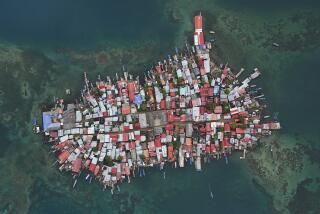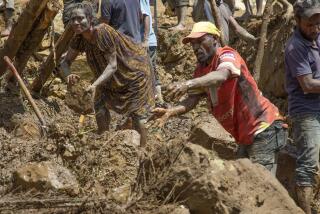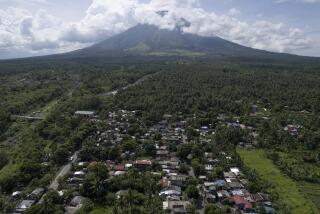U.S. Carrier Evacuates Dependents : Philippines: Women, children and pets forced out by the volcano are welcomed aboard for the trip to Cebu and flights home.
ABOARD THE USS ABRAHAM LINCOLN — In a cavernous jet hangar bay on America’s newest nuclear-powered aircraft carrier, data systems chief Ben Corpus stood by a long table Friday and hawked free Huggies like a ballpark vendor.
“Diapers!” he shouted. “Ladies, diapers! Get your diapers here!”
Nearby, boyish-faced sailors gently carried squalling babies aboard, offered towels to rain-drenched women and children, and carefully tagged a jumble of suitcases. Others tried to calm dozens of pets tied or caged on the hangar floor, awaiting the inevitable din when the ship’s whistle sounds.
“They use the bosun-pipe whistle, a real long, high-pitch whistle,” said electrician’s mate Richard Cunningham, petting two poodles named Misty and Paris. “It drives the dogs crazy.”
So went the giant warship’s generous welcome for some of the last of more than 20,000 military dependents in the Philippines, fleeing volcano-ravaged Subic Bay Naval Base and Clark Air Base in America’s largest peacetime evacuation.
Emotions ran high as families parted, goodbys were said, and final hugs given while the quarter-mile-long ship boarded the 3,000 refugees at a Subic Bay pier. Navy Chief Warrant Officer Kenneth Crowson, 44, broke down and cried as he bade farewell to his wife, Karen, and two children.
“It’s probably for the better they’re able to get out now,” he said as he wept. “And hopefully, shortly, we’ll all be back together again.”
Ligaya Morton, 32, diapered one baby while her two other children watched. Her husband is in Japan and she never got to say goodby. “I feel so helpless,” she said. “So wet and tired and soggy. We’re going to San Diego, and I don’t even know anybody there.”
Others expressed few regrets as they left a country plagued by a seemingly never-ending chain of disasters that peaked last Saturday with the combined fury of a major eruption of Mt. Pinatubo, a nerve-racking series of earthquakes and a passing typhoon.
“I’ve lived here for 10 months and it’s been a nightmare the whole time,” said Lourdes Quinones, 25, as she sipped coffee on the carrier. “From coups to earthquakes, typhoons to floods. The only thing missing was a blizzard. This place is just disaster-ridden.”
The military had its own public-relations disaster, however. The Pentagon apparently rescinded an order, announced by the U.S. Embassy and on Armed Forces Radio here Thursday, to evacuate 4,500 active-duty Air Force personnel as well. An embassy statement Friday afternoon said that “no decision on their status has been made at this time.”
After considerable confusion, Air Force spokesman Maj. Wayne Crist broadcast another radio announcement at 8:30 p.m., ordering all non-essential personnel to immediately board another aircraft carrier, the Midway, for processing. But no order was given to depart, and this morning they were still aboard, awaiting the order to sail.
The U.S. military caused more confusion when armed Marines in full combat gear began directing traffic in downtown Olongapo, outside the Subic base, in apparent violation of U.S.-Philippine agreements. Infuriated local officials were not amused when U.S. Embassy spokesman Stanley Schrager said the Marines “made a hilarious mistake” by directing traffic at a triangle downtown instead of an intersection on the base.
Fifty miles away, other local officials reported panic when U.S. troops at Clark Air Base began detonating stores of ammunition. Schrager said the explosions were “surplus munitions” no longer needed at the nearly deserted air base. The Pentagon has said 3,300 tons of munitions are stored at Clark.
Torrential rains drenched the area all day. Streets in Olongapo were badly flooded, and Filipinos who had returned to ash-clogged homes and villages began fleeing again as landslides and mudslides cascaded off steep hills.
One mudslide cut the road north of Olongapo, where several towns had been virtually flattened by volcanic debris. Another mudflow headed north, threatening a bridge along the Bucau River. In Capas, near the volcano, police reported that three refugee children were swept away by floodwaters.
Increased tremors at Mt. Pinatubo suggested another eruption may be building, said Raymundo Punongbayan, head of the Philippine Institute of Volcanology and Seismology. He warned that growing monsoon rains may trigger floods and devastating mudflows off the unstable volcano.
“When you have a big, big rain, we’ll have a big, big problem,” he warned.
Damage assessments of last weekend’s eruption continued to grow. With nearly 300 reported dead, and a quarter of a million people made homeless, the Philippine Department of Labor and Employment reported that more than 600,000 people, mostly farmers and agricultural workers, may lose their livelihoods because of the vast destruction.
Officially, about 2.2 million people are unemployed in the Philippines, but the figure vastly underestimates conditions in a country where up to half the population lives in poverty. Officials said many of the homeless evacuees may decide to stay in Manila, adding to the crowded capital’s troubles.
More to Read
Sign up for Essential California
The most important California stories and recommendations in your inbox every morning.
You may occasionally receive promotional content from the Los Angeles Times.











